How Do You Bowl on a Flat Wicket: Strategies for Spinners and Pacers
Bowling on flat wickets is a unique challenge that can push even the most skilled bowlers to their limits. Did you know that the fastest recorded ball on a flat pitch still struggled to dismiss well-set batsmen? The key lies not just in raw speed or spin but in tactical precision and adaptability.
Whether you’re a spinner seeking to bamboozle with drift or a pacer working on reverse swing, mastering these conditions demands creativity and discipline. Let’s dive into the techniques that transform flat wickets into grounds of opportunity.
Transform Your Pace Bowling: Proven Strategies for Flat Wickets
Are you struggling to make an impact as a pace bowler on lifeless pitches? You’re not alone. Flat wickets can be a fast bowler’s nightmare, but with the right techniques and mindset, you can turn these challenging conditions into opportunities for success.
Master the Art of Reverse Swing: Your Secret Weapon on Flat Pitches
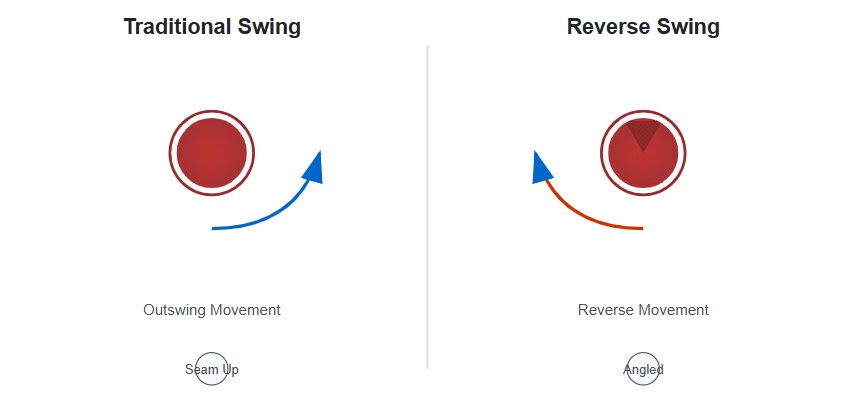
Unlocking reverse swing on flat pitches can be your game-changer. The key lies in understanding the perfect balance between ball maintenance and delivery technique. Here’s how to master this powerful weapon:
Ball Preparation Techniques
- Keep one side smooth: Maintain a glossy finish on one side while allowing controlled roughness on the other
- Apply controlled moisture through natural means (sweat) to enhance shine
- Focus on vertical polishing to maintain the seam’s prominence
- Critical tip: Never cross the line between legal maintenance and tampering
Perfect Your Delivery
- Position the rough side facing your target for inswing
- Release height matters: Maintain a high-arm action for maximum effect
- Crucial timing: Reverse swing is most effective between overs 25-35
- Speed is key: Bowl above 135 kph for optimal reverse swing movement
💡 Pro Tip: Practice your reverse swing techniques with older balls in nets to perfect your control before implementing them in matches.
Outsmart Batsmen with Clever Pace Variations

In modern cricket, a predictable pace is a recipe for disaster. Your arsenal must include carefully crafted variations to keep batsmen guessing.
Essential Variations:
- The Deceptive Slower Ball:
- Back-of-the-hand delivery: Most effective in death overs
- Split-finger variation: Perfect for middle-over control
- Off-cutter grip: Ideal for pitches with slight grip
- The Strategic Bouncer:
- Timing is everything: Use it as a surprise weapon
- Height control: Target between shoulder and head
- Follow up with fuller deliveries for maximum impact
- The Disguised Cutter:
- Subtle seam position changes
- Grip pressure variations for different speeds
- Use the crease angle effectively
Remember: The key to successful variations isn’t just having them in your arsenal – it’s knowing when to use them.
Dominate with Precision: Mastering Line and Length
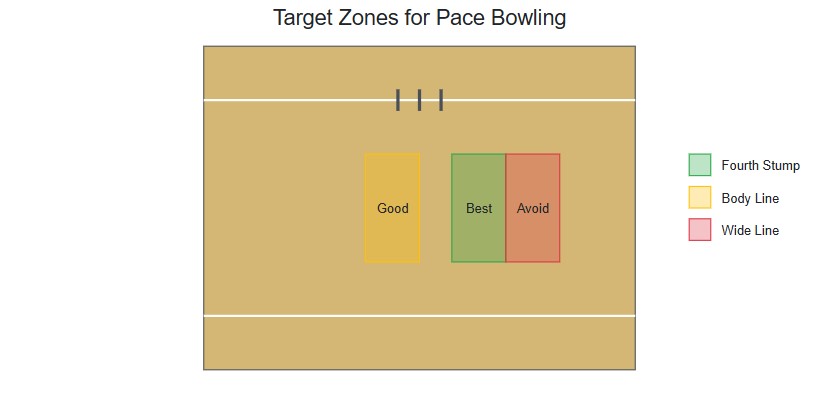
On flat wickets, your margin for error shrinks considerably. Precision becomes your best friend, and here’s how to achieve it:
The Fourth Stump Line
- Target Area: Just outside off stump
- Creates uncertainty in the batsman’s mind
- Forces technical errors through patience
- Perfect Length: 6-8 meters from stumps
Body-Line Strategy
- Tactical Implementation:
- Set appropriate fields for catch opportunities
- Mix lengths to prevent batsman from settling
- Use it as a surprise weapon, not a constant plan
Key Success Factor: Maintain unwavering consistency with your line and length for at least 4-5 overs to build pressure.
Exploit Surface Variations Like a Pro

Even the flattest wickets have their secrets. Learning to identify and exploit subtle surface variations can give you a crucial advantage.
Finding Your Spots
- Look for slight cracks or rough patches
- Study how the ball behaves during warm-up
- Identify areas where footmarks might develop
- Monitor changes throughout the day’s play
Length Manipulation
- Vary your release point slightly
- Use cross-seam deliveries on identified spots
- Surprise factor: Occasional effort ball targeting uneven areas
💡 Pro Tip: Keep a mental note of which areas produce unpredictable bounce and revisit them strategically throughout your spell.
Develop a Winner’s Mindset: Mental Toughness for Pacers
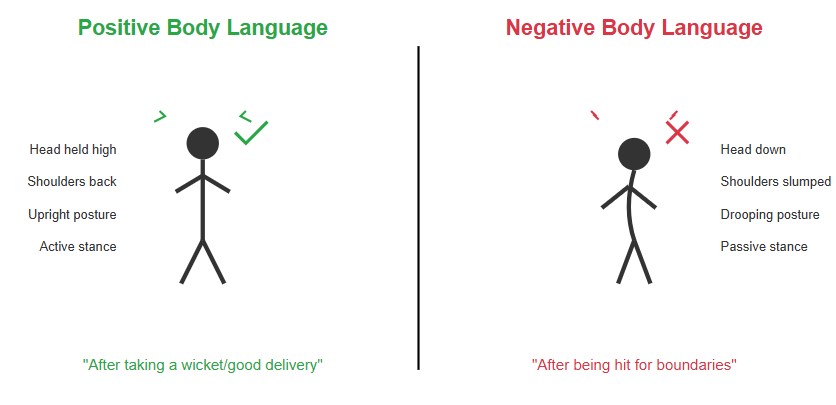
Success on flat wickets requires more than just technical skills – it demands mental fortitude and strategic thinking.
Building Pressure
- Focus on dot ball percentage
- Maintain consistent field settings
- Stay patient even when wickets aren’t falling
- Create pressure through tight bowling spells
Strategic Thinking
- Set-Play Tactics:
- Plan sequences of deliveries
- Work with your captain on field placements
- Study batsman’s patterns and weaknesses
- Maintaining Focus:
- Positive body language even when hit for boundaries
- Quick recovery between overs
- Clear plans for each new batsman
Remember: On flat wickets, success often comes to those who can maintain their disciplines the longest.
Quick Reference: Do’s and Don’ts
✅ Do’s:
- Maintain consistent seam position
- Regular ball maintenance (legally)
- Communicate with your captain
- Stay patient with your plans
- Use variations sparingly but effectively
❌ Don’ts:
- Over-experiment with variations
- Lose focus after boundaries
- Neglect field placements
- Rush through your overs
- Ignore signs of reverse swing
By mastering these techniques and maintaining a positive mindset, you’ll be well-equipped to handle the challenges of bowling on flat wickets. Remember, some of cricket’s most memorable spells have come on the flattest of surfaces – yours could be next!
Dominate as a Spinner: Expert Tactics for Flat Wickets
Even on the flattest wickets, spin bowling can be a match-winning weapon. Learn how to master the art of deception and control with these proven strategies that work even when the pitch offers minimal assistance.
Master Flight and Drift: Your Ultimate Weapons in the Air
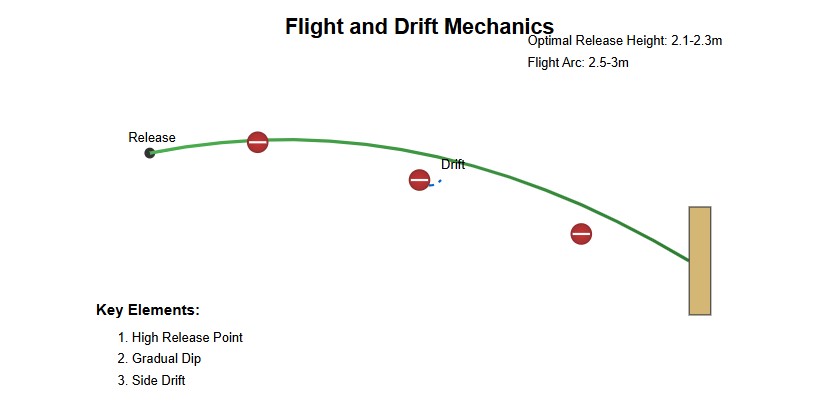
When the pitch isn’t your friend, the air becomes your playground. Understanding how to use flight and drift effectively can make you dangerous even on batting paradises.
Mastering Flight Control
- Release point is crucial: Higher release = more dip and bounce
- Create a compelling arc by bowling with a high-arm action
- Use your wrist position to control the ball’s trajectory
- Vital tip: The slower through the air, the more time for drift
Unlocking Drift Mastery
- Focus on maximum revolutions at release
- Keep your arm speed consistent but vary release points
- Use the breeze direction to enhance natural drift
- Practice drill: Bowl into the wind to strengthen your action
💡 Pro Tip: “The best spinners don’t just spin the ball – they master the space between release and impact.”
Become Unpredictable: Variation is Your Secret Weapon
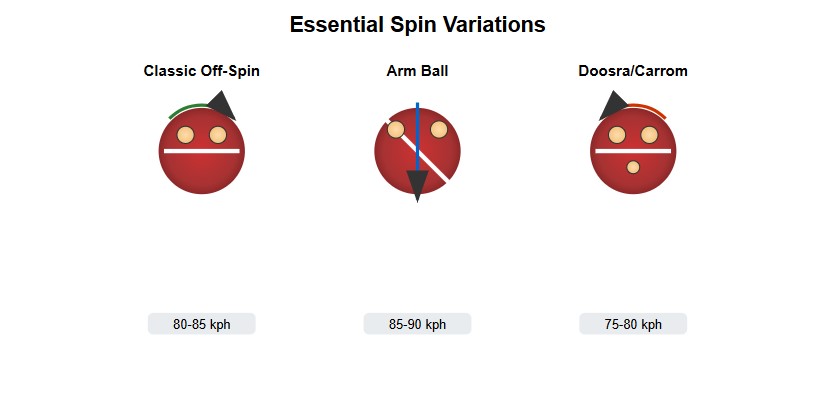
In modern cricket, predictability is your enemy. Your arsenal must include carefully crafted variations that keep batsmen guessing without losing control.
Speed Variations:
- The Quick One:
- Push it through slightly faster
- Maintain the same action
- Perfect for batsmen looking to use their feet
- The Floater:
- Release with less spin but same arm speed
- Hold the ball slightly looser
- Excellent against aggressive batsmen
- The Subtly Different One:
- Change pace by 8-10 kph maximum
- Keep your action identical
- Most effective when batsmen are set
Alternative Deliveries:
- The Arm Ball: Your weapon against the defensive blade
- The Slider: Perfect for catching aggressive batsmen off guard
- The Top-Spinner: When you need extra bounce
Command Your Territory: Lines, Lengths, and Angles
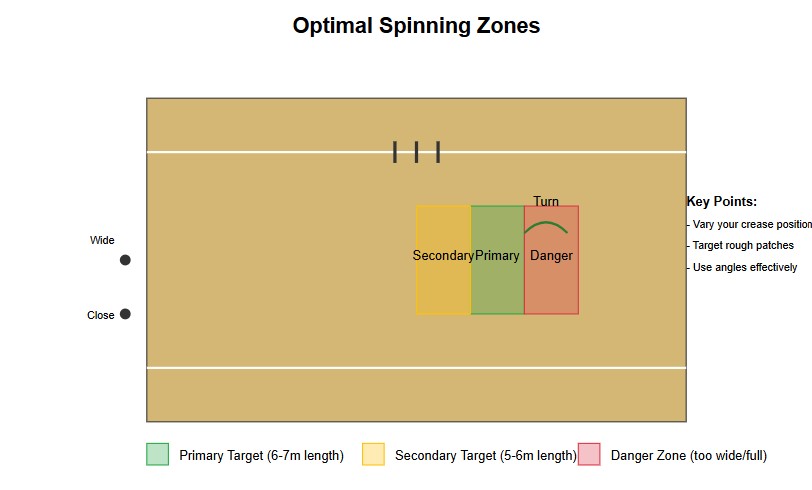
Location is everything in spin bowling. On flat wickets, your margin for error shrinks, but your options for creativity expand.
The Perfect Line
- For Off-Spinners:
- Target line: Just outside off stump
- Allow natural spin to create uncertainty
- Force batsmen to play against the spin
- For Leg-Spinners:
- Middle and leg line
- Use the natural variation
- Make them play every ball
Creative Use of the Crease
- Wide of the crease: Changes the angle of spin
- Close to the stumps: Maximizes natural variation
- Walking in: Adds flight and dip element
Strategic Field Settings: Your Support System
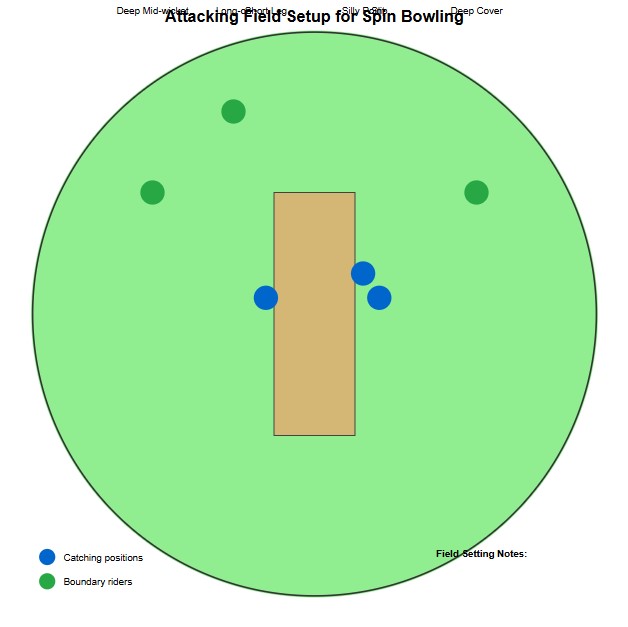
Your field placement should tell a story and support your bowling plan. Smart field settings can make average deliveries look dangerous.
Attacking Fields
- Close catchers are crucial:
- Slip for the turner
- Short leg for the top spinner
- Silly point for the hesitant batsman
Defensive with a Twist
- Save boundaries but keep catchers
- Place fielders in positions that create doubt
- Adjust frequently to keep batsmen thinking
Winning the Mental Battle: Game Awareness and Patience
Success on flat wickets requires mental strength as much as physical skill. Understanding game situations and batting mindsets is crucial.
Reading the Game
- Study batsman’s trigger movements
- Notice their scoring patterns
- Identify their weak zones
Building Pressure
- Dot Ball Strategy:
- Focus on consistency
- Make them earn every run
- Create uncertainty with subtle changes
- Over Planning:
- First three balls: Set the tone
- Middle two: Create pressure
- Final ball: Go for the wicket
Quick Reference: The Spinner’s Checklist
✅ Do’s:
- Maintain consistent action across variations
- Use the crease creatively
- Stay patient with your plans
- Keep your field engaged
- Trust your stock ball
❌ Don’ts:
- Rush through your overs
- Overuse variations
- Ignore field placement
- Get discouraged by boundaries
- Forget your stock ball
Remember: Flat wickets challenge your creativity and patience. By mastering these techniques and maintaining a positive mindset, you can turn seemingly batting-friendly conditions into your advantage. Some of cricket’s most memorable spinning spells have come on the flattest of surfaces – yours could be next!
Transform Your Game: Avoid These Critical Bowling Mistakes on Flat Wickets
Are your bowling spells on flat wickets not yielding results? You might be falling into common traps that even experienced bowlers face. Let’s break down these mistakes and learn how to overcome them.
Overusing Short-Pitched Deliveries or Trying Too Hard for Movement
On flat wickets, it’s tempting to rely on short-pitched deliveries to intimidate batsmen or search excessively for swing. However, this approach can backfire. Short-pitched balls on flat wickets often sit up nicely for batsmen, making them easy to score off.
Instead:
- Focus on maintaining a consistent length, targeting the top of the off-stump.
- Use short balls as a surprise element rather than a default option.
- Accept that swing and seam movement might be limited and adjust your tactics accordingly.
Not Adapting Quickly to Batsman Strategies
One of the biggest mistakes bowlers make is sticking to a predetermined plan without considering how the batsman is approaching their innings. Failing to adapt allows the batsman to settle and dominate.
To counter this:
- Observe the batsman’s footwork, scoring areas, and shot selection early in their innings.
- Be prepared to vary your line, length, and pace based on what’s working.
- Communicate with your captain and teammates to tweak your strategy in real-time.
Setting Defensive Fields Too Early in the Spell
Flat wickets can make it tempting to prioritize run-saving over wicket-taking from the outset. However, setting overly defensive fields too early gives the batsman a psychological advantage and reduces wicket-taking opportunities.
What to do instead:
- Start with attacking fields to put pressure on the batsman.
- Position close-in fielders to capitalize on early chances.
- Gradually transition to defensive fields only if necessary, based on the match situation.
Avoiding these common mistakes requires a combination of discipline, adaptability, and game awareness. By focusing on precise execution and staying flexible in your approach, you can turn flat wickets into opportunities for success.
Transform Your Practice: Master Bowling for Flat Wickets
To succeed on flat wickets, practice sessions must simulate real match conditions and focus on specific skills. Here’s how you can train effectively to master the art of bowling on flat tracks:
Drill Ideas for Spinners and Pacers to Simulate Flat Wicket Conditions
Flat wickets often offer little assistance to bowlers, so your practice drills should emphasize accuracy and control. Here are some effective drills:
- For Spinners:
- Set up cones just outside the off-stump to perfect your line and length.
- Use a batsman during practice to test your flight and variations against aggressive strokes.
- Practice bowling to specific field placements, like a short leg or slip, to develop wicket-taking deliveries.
- For Pacers:
- Mark zones on the pitch for a good length and aim to consistently land the ball within those areas.
- Simulate reverse swing conditions by using older balls during net sessions.
- Alternate between slower balls, bouncers, and yorkers to build muscle memory for variations.
Practicing Reverse Swing and Variations in the Nets
Reverse swing is a critical skill for pacers on flat wickets, while spinners need to master subtle variations. Here’s how to practice both:
- Reverse Swing:
- Use scuffed-up or older balls to replicate match conditions.
- Practice bowling with one side of the ball polished and the other rough.
- Focus on your wrist position and seam alignment to control the swing direction.
- Variations:
- For spinners, practice releasing arm balls, sliders, or carrom balls to surprise batsmen.
- Pacers should experiment with grip pressure and seam positioning to execute off-cutters and leg-cutters effectively.
Effective practice for flat wickets involves replicating match scenarios, focusing on precision, and mastering variations. By integrating these drills into your routine, you’ll develop the confidence and skill to excel even on the toughest pitches.
Elevate Your Bowling Game on Lifeless Tracks
Bowling on flat wickets may seem daunting, but armed with the right strategies, you can turn even the most lifeless tracks into opportunities for dominance. From mastering reverse swing and pace variations to harnessing flight and spin, success lies in discipline, adaptability, and precision.
Whether you’re a spinner or pacer, consistent practice and tactical execution are your keys to outsmarting batsmen on flat pitches. Stay patient, read the game, and let your creativity shine.
Dive deeper into the world of cricket! Explore Cricket Corner for the latest ICC events, breaking news on bilateral series, and in-depth coverage of T20 leagues.






